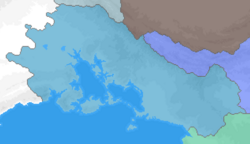Difference between revisions of "Pavo-Shavakhotian Empire"
| Line 148: | Line 148: | ||
At its core was a constitutional monarchy, which was a union between the former [[Lenezan|Lenezi Empire]] and the [[Shavakhotia|Shavakhotian Empire]]. Following the 1810 reforms, the Lenezi state held precedence over the Shavakhotian state in terms of power. The two states conducted common foreign, defense, and financial policies, but all other governmental faculties were divided among respective states. A third component of the union was the [[Loheta|Kingdom of Loheta]], an autonomous region under the Lenezi crown, which negotiated the Pavo–Lohetan Settlement in XXXX. | At its core was a constitutional monarchy, which was a union between the former [[Lenezan|Lenezi Empire]] and the [[Shavakhotia|Shavakhotian Empire]]. Following the 1810 reforms, the Lenezi state held precedence over the Shavakhotian state in terms of power. The two states conducted common foreign, defense, and financial policies, but all other governmental faculties were divided among respective states. A third component of the union was the [[Loheta|Kingdom of Loheta]], an autonomous region under the Lenezi crown, which negotiated the Pavo–Lohetan Settlement in XXXX. | ||
Pavakhotia entered into the Pavo-Vos Coal War against the Vos Empire in 1861. Pavakhotia's defeat in the war, and subsequent loss of the territories of Solama and Ževuzah triggered the Slow Decay, a period of three decades in which the empire cascaded towards its downfall. Pavokhotia collapsed in the [[First Lenezi Civil War]] in 1895, with Shavakhotian and Lohetan resistance groups breaking off separately in 1896. With the signing of the Treaty of Wataful, the empire was officially dissolved. The [[Lenezan|Reformed Kingdom of Lenezan]] and the [[Shavakhotia|First Republic of Shavakhotia]] were treated as its successors de jure, whereas the independence of the Southeastern Rietics of Pavakhotia as the [[Loheta|Castles of Loheta]], and the annexation of | Pavakhotia entered into the Pavo-Vos Coal War against the Vos Empire in 1861. Pavakhotia's defeat in the war, and subsequent loss of the territories of Solama and Ževuzah triggered the Slow Decay, a period of three decades in which the empire cascaded towards its downfall. Pavokhotia collapsed in the [[First Lenezi Civil War]] in 1895, with Shavakhotian and Lohetan resistance groups breaking off separately in 1896. With the signing of the Treaty of Wataful, the empire was officially dissolved. The [[Lenezan|Reformed Kingdom of Lenezan]] and the [[Shavakhotia|First Republic of Shavakhotia]] were treated as its successors de jure, whereas the independence of the Southeastern Rietics of Pavakhotia as the [[Loheta|Castles of Loheta]], and the annexation of Rolbosan by the Faichani Empire were also recognized by the treaty in 1901. | ||
==Etymology== | ==Etymology== | ||
Revision as of 22:29, 24 May 2023
| Pavo-Shavakhotian Empire | |||||
| |||||
Map of Pavo-Shavakhotian Empire at its height in 1796
| |||||
| Capital | Ihana | ||||
| Languages | Siyan, Shavakhoti | ||||
| Government | Monarchy | ||||
| History | |||||
| • | Established | 1787 | |||
| • | First Lenezi Civil War | 1901 | |||
| Today part of | |||||
Pavakhotia, often referred to as the Pavo-Shavakhotian Empire, or Lenezan, was a constitutional monarchy and great power in Western Vaniua between 1787 and 1895. Pavakhotia was a military and diplomatic alliance of two sovereign states. It was formed with the Treaty of Afąván in the aftermath of the First Váňudeic War and was dissolved after the beginning of the First Lenezi Civil War.
Pavakhotia was ruled by the House of Taceyejirid, which is the current royal family of Lenezan. It was a multinational state and one of Vaniua's major powers at the time. Pavakhotia was geographically the fourth-largest country in Vaniua at the time after the Faichani Empire, Vos Empire, and Vogian Empire, at around 1,128,470 km2 (~435,705 sq mi), and was the X-most populous. Pavakhotia was also the second country to industrialize after Vosan in Vaniua during the 1840s.
At its core was a constitutional monarchy, which was a union between the former Lenezi Empire and the Shavakhotian Empire. Following the 1810 reforms, the Lenezi state held precedence over the Shavakhotian state in terms of power. The two states conducted common foreign, defense, and financial policies, but all other governmental faculties were divided among respective states. A third component of the union was the Kingdom of Loheta, an autonomous region under the Lenezi crown, which negotiated the Pavo–Lohetan Settlement in XXXX.
Pavakhotia entered into the Pavo-Vos Coal War against the Vos Empire in 1861. Pavakhotia's defeat in the war, and subsequent loss of the territories of Solama and Ževuzah triggered the Slow Decay, a period of three decades in which the empire cascaded towards its downfall. Pavokhotia collapsed in the First Lenezi Civil War in 1895, with Shavakhotian and Lohetan resistance groups breaking off separately in 1896. With the signing of the Treaty of Wataful, the empire was officially dissolved. The Reformed Kingdom of Lenezan and the First Republic of Shavakhotia were treated as its successors de jure, whereas the independence of the Southeastern Rietics of Pavakhotia as the Castles of Loheta, and the annexation of Rolbosan by the Faichani Empire were also recognized by the treaty in 1901.

